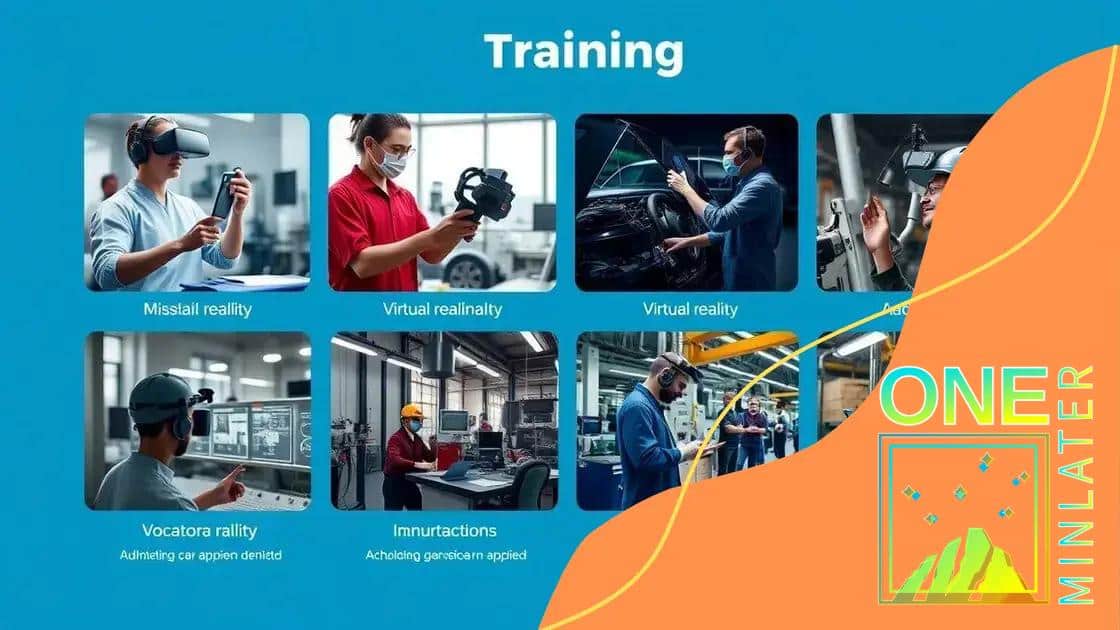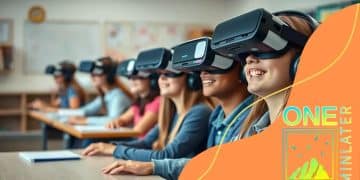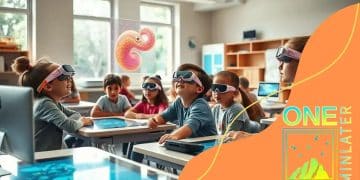The role of AR/VR in hands-on vocational training

The role of AR/VR in hands-on vocational training significantly enhances learning by providing immersive experiences, safe environments for skill practice, and personalized educational pathways across various industries.
The role of AR/VR in hands-on vocational training is transforming how students engage with their learning. Have you ever wondered how these immersive technologies can enhance practical skills? Let’s explore!
Understanding AR and VR technologies
Understanding the difference between AR (Augmented Reality) and VR (Virtual Reality) is essential in grasping how these technologies are transforming vocational training. While both create immersive experiences, they serve different purposes and utilize distinct methods.
Augmented Reality (AR) overlays digital information onto the real world. This technology enhances the user’s perception of their surroundings, making it ideal for hands-on training. For example, a student learning to repair machinery can see real-time instructions and visual guides projected onto the equipment they are working on.
Features of AR:
- Integration with real-world elements
- Interactive overlaid content
- Use of mobile devices and smart glasses
Conversely, Virtual Reality (VR) immerses the user in a fully virtual environment. This creates a complete sense of presence in a three-dimensional space, providing an excellent platform for training in high-risk professions. For instance, trainees in firefighting can experience simulated fire scenarios without the danger.
Features of VR:
- Fully immersive experiences
- Utilizes VR headsets
- Safe training for hazardous environments
Both AR and VR offer unique advantages in vocational training. By allowing students to interact with digital objects, these technologies make the learning process more engaging and effective. Moreover, they provide opportunities to practice skills safely before entering real-world scenarios.
This innovative approach to education can significantly boost retention rates. As learners actively engage with the material, they’re more likely to remember what they’ve practiced. Additionally, AR and VR can cater to different learning styles, thus enhancing the overall training experience.
Benefits of AR/VR in vocational training
Understanding the benefits of AR (Augmented Reality) and VR (Virtual Reality) in vocational training is crucial for educators and institutions. These technologies offer innovative solutions that enhance the learning experience and provide practical skill development.
One of the most significant advantages of AR and VR is their ability to create immersive learning environments. Students can interact with digital elements in real-world scenarios. This helps them to grasp complex concepts more easily, as they can visualize the application of their skills.
Key Benefits of AR/VR:
- Enhanced Engagement: Students are more likely to stay focused with interactive content.
- Safe Learning Environment: Trainees can practice skills without real-life risks.
- Immediate Feedback: Learners receive real-time evaluation on their performance.
- Cost-Effective Training: Less need for physical materials reduces expenses.
AR and VR also cater to different learning styles. Visual learners benefit from seeing virtual tools in action, while kinesthetic learners gain from hands-on experience. This adaptability ensures that all students receive the support they need to succeed.
Another benefit is the accessibility that AR and VR provide. Content can be made available anywhere and anytime, allowing learners to practice skills at their own pace. This flexibility is essential, especially for adult learners who may have other commitments.
Moreover, AR and VR can simulate situations that are hard to replicate in real life. For example, in fields like healthcare, trainees can practice medical procedures in a risk-free virtual environment, preparing them for real-world applications with confidence.
Real-world applications of AR/VR

The real-world applications of AR (Augmented Reality) and VR (Virtual Reality) in vocational training are vast and varied. These technologies are not just concepts but are actively shaping how training is conducted across different industries.
One noteworthy application is in the field of healthcare. Medical students can use VR to practice surgical procedures in a controlled environment. This allows them to gain valuable experience without the risks associated with real surgeries. They can repeat procedures multiple times until they feel confident.
Other significant applications include:
- Manufacturing: Workers can use AR to receive assembly instructions overlaid on their work, improving accuracy and efficiency.
- Aviation: Pilots can train in VR simulations that mimic real flight conditions, enhancing their readiness for actual flights.
- Construction: AR can help architects and builders visualize designs in real-time, making it easier to identify potential issues before construction begins.
In the automotive industry, technicians utilize AR for vehicle repairs. They can see step-by-step instructions projected onto the car, allowing for quicker and more accurate repairs. This reduces the time needed for training and helps technicians adapt to new technologies swiftly.
Moreover, AR and VR can enhance soft skills training as well. For example, retail workers can practice customer interactions through VR scenarios, developing their communication and problem-solving abilities in a safe environment.
The versatility of these technologies makes them suitable for a range of applications, adapting to the unique needs of different fields. As more organizations recognize the advantages, the use of AR and VR in vocational training will continue to grow.
Challenges and limitations of AR/VR
While AR (Augmented Reality) and VR (Virtual Reality) offer remarkable benefits in vocational training, they also come with their own set of challenges and limitations. These hurdles can impact their effectiveness and adoption in educational contexts.
One major challenge is the initial cost of technology. Setting up AR and VR systems often requires significant investment in hardware and software. Many institutions may find it difficult to allocate funds for these technologies.
Other common challenges include:
- Technical Skills Requirement: Trainers and educators need a certain level of technical expertise to implement and maintain AR/VR systems effectively.
- Integration with Existing Curriculum: Adapting current training programs to incorporate AR and VR can be complex and time-consuming.
- Accessibility Concerns: Not all students may have equal access to the necessary devices, which can create disparities in learning opportunities.
Moreover, users can experience discomfort or motion sickness when using VR. This can deter students from fully engaging with the technology. It’s crucial for developers to create user-friendly experiences that minimize these side effects.
Another limitation is the content availability. High-quality AR and VR training materials are still in development. As the market grows, the diversity and quality of content will likely improve, but currently, choices may be limited.
Despite these challenges, it’s evident that AR and VR have the potential to revolutionize vocational training. As solutions to these limitations are explored, more institutions may be motivated to embrace these transformative technologies.
Future trends in vocational training with AR/VR
The future trends in vocational training with AR (Augmented Reality) and VR (Virtual Reality) promise to reshape how skills are taught and acquired. As technology evolves, so do the possibilities for effective training methods that make learning more engaging.
One significant trend is the increased use of virtual simulations. As VR technology becomes more accessible, institutions will likely adopt simulations that allow students to practice in realistic environments. For example, medical students can perform surgeries in a VR setting that mimics a real surgical room.
Emerging trends include:
- Personalized Learning Experiences: Utilizing AR and VR can help tailor lessons to meet individual student needs and learning paces.
- Collaborative Learning: Future AR applications might enable teams of learners to work together in virtual environments, encouraging teamwork and communication.
- Integration with AI: Combining AR/VR with artificial intelligence can create adaptive learning platforms that respond to a learner’s progress and challenges.
Moreover, as 5G technology becomes widely available, it will enhance the capabilities of AR and VR. Lower latency and higher data speeds will allow for smoother interactions and more immersive experiences. This advancement will help overcome many of the current technical limitations.
In addition, industries are expected to focus more on soft skills training with AR and VR. Role-playing scenarios in virtual settings can improve communication, negotiation, and leadership skills among trainees, making them more effective in their careers.
With the ongoing development of AR and VR technologies, the potential for innovation in vocational training is immense. As educators and industry leaders explore these possibilities, the training landscape will undoubtedly become richer and more varied.
FAQ – Frequently Asked Questions about AR/VR in Vocational Training
What are the benefits of using AR/VR in vocational training?
AR/VR enhances engagement, provides hands-on experience in a safe environment, and allows for personalized learning.
What challenges do schools face when implementing AR/VR?
The main challenges include high initial costs, the need for technical skills, and ensuring all students have access to the necessary devices.
How can AR/VR improve soft skills training?
AR/VR allows students to participate in realistic simulations where they can practice communication and teamwork in virtual environments.
What future trends are expected in AR/VR for vocational training?
Future trends include more personalized learning experiences, integrated AI solutions, and enhanced collaboration features through AR/VR platforms.





